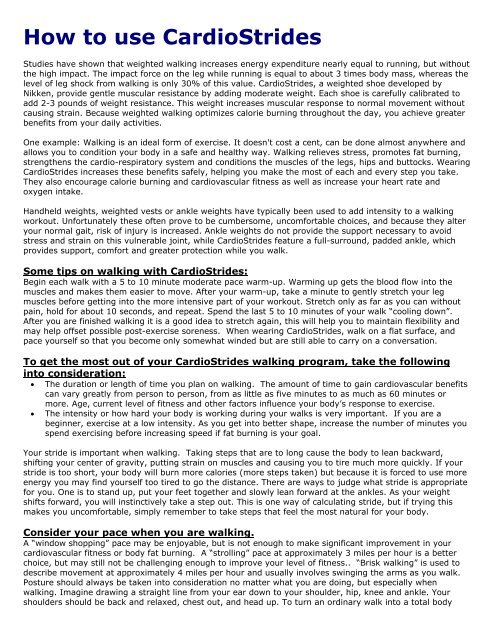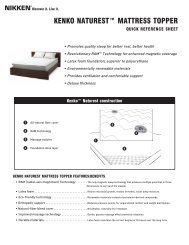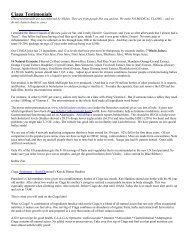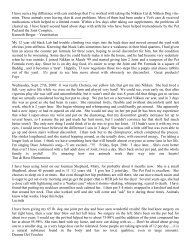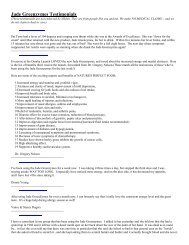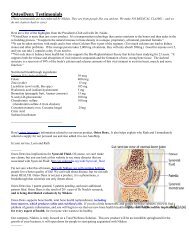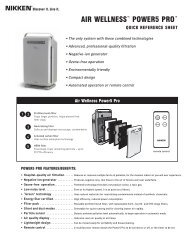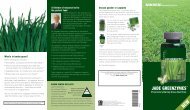How to Use Cardiostrides - Nikken Wellness Products & Nikken ...
How to Use Cardiostrides - Nikken Wellness Products & Nikken ...
How to Use Cardiostrides - Nikken Wellness Products & Nikken ...
Create successful ePaper yourself
Turn your PDF publications into a flip-book with our unique Google optimized e-Paper software.
<strong>How</strong> <strong>to</strong> use CardioStrides<br />
Studies have shown that weighted walking increases energy expenditure nearly equal <strong>to</strong> running, but without<br />
the high impact. The impact force on the leg while running is equal <strong>to</strong> about 3 times body mass, whereas the<br />
level of leg shock from walking is only 30% of this value. CardioStrides, a weighted shoe developed by<br />
<strong>Nikken</strong>, provide gentle muscular resistance by adding moderate weight. Each shoe is carefully calibrated <strong>to</strong><br />
add 2-3 pounds of weight resistance. This weight increases muscular response <strong>to</strong> normal movement without<br />
causing strain. Because weighted walking optimizes calorie burning throughout the day, you achieve greater<br />
benefits from your daily activities.<br />
One example: Walking is an ideal form of exercise. It doesn't cost a cent, can be done almost anywhere and<br />
allows you <strong>to</strong> condition your body in a safe and healthy way. Walking relieves stress, promotes fat burning,<br />
strengthens the cardio-respira<strong>to</strong>ry system and conditions the muscles of the legs, hips and but<strong>to</strong>cks. Wearing<br />
CardioStrides increases these benefits safely, helping you make the most of each and every step you take.<br />
They also encourage calorie burning and cardiovascular fitness as well as increase your heart rate and<br />
oxygen intake.<br />
Handheld weights, weighted vests or ankle weights have typically been used <strong>to</strong> add intensity <strong>to</strong> a walking<br />
workout. Unfortunately these often prove <strong>to</strong> be cumbersome, uncomfortable choices, and because they alter<br />
your normal gait, risk of injury is increased. Ankle weights do not provide the support necessary <strong>to</strong> avoid<br />
stress and strain on this vulnerable joint, while CardioStrides feature a full-surround, padded ankle, which<br />
provides support, comfort and greater protection while you walk.<br />
Some tips on walking with CardioStrides:<br />
Begin each walk with a 5 <strong>to</strong> 10 minute moderate pace warm-up. Warming up gets the blood flow in<strong>to</strong> the<br />
muscles and makes them easier <strong>to</strong> move. After your warm-up, take a minute <strong>to</strong> gently stretch your leg<br />
muscles before getting in<strong>to</strong> the more intensive part of your workout. Stretch only as far as you can without<br />
pain, hold for about 10 seconds, and repeat. Spend the last 5 <strong>to</strong> 10 minutes of your walk “cooling down”.<br />
After you are finished walking it is a good idea <strong>to</strong> stretch again, this will help you <strong>to</strong> maintain flexibility and<br />
may help offset possible post-exercise soreness. When wearing CardioStrides, walk on a flat surface, and<br />
pace yourself so that you become only somewhat winded but are still able <strong>to</strong> carry on a conversation.<br />
To get the most out of your CardioStrides walking program, take the following<br />
in<strong>to</strong> consideration:<br />
The duration or length of time you plan on walking. The amount of time <strong>to</strong> gain cardiovascular benefits<br />
can vary greatly from person <strong>to</strong> person, from as little as five minutes <strong>to</strong> as much as 60 minutes or<br />
more. Age, current level of fitness and other fac<strong>to</strong>rs influence your body’s response <strong>to</strong> exercise.<br />
The intensity or how hard your body is working during your walks is very important. If you are a<br />
beginner, exercise at a low intensity. As you get in<strong>to</strong> better shape, increase the number of minutes you<br />
spend exercising before increasing speed if fat burning is your goal.<br />
Your stride is important when walking. Taking steps that are <strong>to</strong> long cause the body <strong>to</strong> lean backward,<br />
shifting your center of gravity, putting strain on muscles and causing you <strong>to</strong> tire much more quickly. If your<br />
stride is <strong>to</strong>o short, your body will burn more calories (more steps taken) but because it is forced <strong>to</strong> use more<br />
energy you may find yourself <strong>to</strong>o tired <strong>to</strong> go the distance. There are ways <strong>to</strong> judge what stride is appropriate<br />
for you. One is <strong>to</strong> stand up, put your feet <strong>to</strong>gether and slowly lean forward at the ankles. As your weight<br />
shifts forward, you will instinctively take a step out. This is one way of calculating stride, but if trying this<br />
makes you uncomfortable, simply remember <strong>to</strong> take steps that feel the most natural for your body.<br />
Consider your pace when you are walking.<br />
A “window shopping” pace may be enjoyable, but is not enough <strong>to</strong> make significant improvement in your<br />
cardiovascular fitness or body fat burning. A “strolling” pace at approximately 3 miles per hour is a better<br />
choice, but may still not be challenging enough <strong>to</strong> improve your level of fitness.. “Brisk walking” is used <strong>to</strong><br />
describe movement at approximately 4 miles per hour and usually involves swinging the arms as you walk.<br />
Posture should always be taken in<strong>to</strong> consideration no matter what you are doing, but especially when<br />
walking. Imagine drawing a straight line from your ear down <strong>to</strong> your shoulder, hip, knee and ankle. Your<br />
shoulders should be back and relaxed, chest out, and head up. To turn an ordinary walk in<strong>to</strong> a <strong>to</strong>tal body
activity, try <strong>to</strong> incorporate arm movement. Instead of just letting your arms hang at your sides, bend them<br />
at the elbows at about a 90 degree angle and swing them in natural rhythm with your body. Adding arm<br />
movement increases calorie burning by as much as 5-10%.<br />
The following cautions are recommended:<br />
* Read instructions carefully before using CardioStrides.<br />
* Consult your health care provider before starting any exercise program.<br />
* Do not wear this product while operating any vehicle.<br />
CardioStrides are designed for walking or other activities that involve low-impact, low-speed exercise. Rapid,<br />
high-impact activity while wearing them may cause damage <strong>to</strong> muscles and joints. Wear these shoes only on<br />
flat, even ground. They are not recommended for wear on stairs, slopes, and escala<strong>to</strong>rs or in slippery<br />
conditions such as snow or rain, or water.


